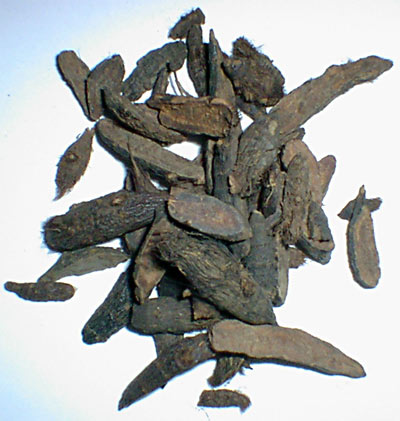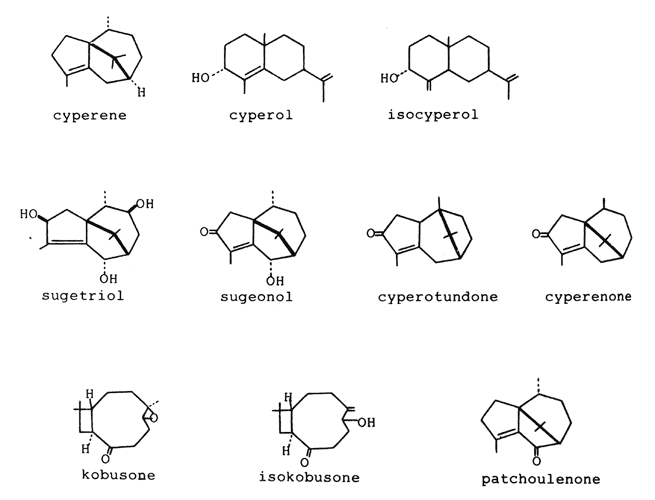CYPERUS
PRIMARY
QI REGULATING HERB OF CHINESE MEDICINE
BACKGROUND
 Cyperus
is known in Chinese as xiangfu or xiangfuzi. The term xiang means fragrant, and usually is applied to strong and
pleasant fragrances, such as those occurring in culinary spices,
perfumes, and incenses. The character fu is the same as that
used to describe aconite (fuzi); the term was likely used
because the appearance of the cyperus rhizomes, the part used,
reminded herbalists of the aconite roots. In much of the rest of the
world, cyperus is referred to as nutgrass or purple nutsedge (sedge
is a term indicating blade-like leaves and rush-like stems and is
often applied to the plants of the entire Cyperaceae family); the nut
is the rhizome (or tuber), which forms rounded or elongated balls
along a tangle of thin roots (see artists drawing of three species of Cyperus below, showing roots and rhizomes; C. rotundus is the one pictured on the right).
Cyperus
is known in Chinese as xiangfu or xiangfuzi. The term xiang means fragrant, and usually is applied to strong and
pleasant fragrances, such as those occurring in culinary spices,
perfumes, and incenses. The character fu is the same as that
used to describe aconite (fuzi); the term was likely used
because the appearance of the cyperus rhizomes, the part used,
reminded herbalists of the aconite roots. In much of the rest of the
world, cyperus is referred to as nutgrass or purple nutsedge (sedge
is a term indicating blade-like leaves and rush-like stems and is
often applied to the plants of the entire Cyperaceae family); the nut
is the rhizome (or tuber), which forms rounded or elongated balls
along a tangle of thin roots (see artists drawing of three species of Cyperus below, showing roots and rhizomes; C. rotundus is the one pictured on the right).
 The
plant is considered an invasive weed; it has been called “the
world’s worst weed.” The plant requires sun and moist
conditions, though it grows in sandy soil (one of the old Chinese
names for it was shacao, meaning sand weed), as well as in
loamy moist fields and in tropical rainforests. It has a vast
growing range, crossing the globe and particularly noted in the
Pacific Islands (where its leaves are used for weaving) as well as
along coastal regions. It is especially prevalent in southern India,
where its essential oil is used in perfumery. As an invasive weed,
it is considered troublesome in 92 countries and adversely affects
more than 50 crops, including sugar cane, corn, cotton, rice, and
many vegetables. Cyperus grows rapidly and fills the soil with its
tangle of roots and rhizomes; this one species (C. rotundus)
can produce up to 40,000 kg/hectare of underground plant material.
In addition to taking up nutrients and physical space, the plant
produces sesquiterpenes, accumulating in the rhizomes, which inhibit
the growth of other plants.
The
plant is considered an invasive weed; it has been called “the
world’s worst weed.” The plant requires sun and moist
conditions, though it grows in sandy soil (one of the old Chinese
names for it was shacao, meaning sand weed), as well as in
loamy moist fields and in tropical rainforests. It has a vast
growing range, crossing the globe and particularly noted in the
Pacific Islands (where its leaves are used for weaving) as well as
along coastal regions. It is especially prevalent in southern India,
where its essential oil is used in perfumery. As an invasive weed,
it is considered troublesome in 92 countries and adversely affects
more than 50 crops, including sugar cane, corn, cotton, rice, and
many vegetables. Cyperus grows rapidly and fills the soil with its
tangle of roots and rhizomes; this one species (C. rotundus)
can produce up to 40,000 kg/hectare of underground plant material.
In addition to taking up nutrients and physical space, the plant
produces sesquiterpenes, accumulating in the rhizomes, which inhibit
the growth of other plants.
For medicinal use in China, the underground portion is collected in autumn, cooked for a short time in boiling water or steamed, with the fibrous roots burnt off; the rhizomes are sliced in half down the center, and dried in the sun.
ACTIVE CONSTITUENTS
 Cyperus,
like other plants, has numerous chemical constituents, many of which
may show pharmacological activity, but the main active components
appear to be the sesquiterpenes. These are aromatic, spicy tasting
molecules. Among the main sesquiterpenes identified in cyperus
rhizomes thus far are:
Cyperus,
like other plants, has numerous chemical constituents, many of which
may show pharmacological activity, but the main active components
appear to be the sesquiterpenes. These are aromatic, spicy tasting
molecules. Among the main sesquiterpenes identified in cyperus
rhizomes thus far are:
α-cyperone, β-selinene, cyperene, cyperotundone, patchoulenone, sugeonol, kobusone, and isokobusone.
Cyperus also contains other terpenes, such as the commonly occurring plant component pinene (a monoterpene), and several derivatives of the sesquiterpenes, such as cyperol, isocyperol, and cyperone.

These active constituents are found in the volatile oil of cyperus rhizomes, which makes up only about 0.5–1% of the dried rhizome; prolonged cooking of the herb will cause loss of some portion of these constituents. Their main pharmacological actions may be antispasmodic and analgesic effects.
APPLICATIONS
Cyperus
is considered by many traditional practitioners to be the best
Chinese herb for alleviating depression of qi circulation. According
to Jiao Shude (1):
Acrid and slightly bitter in flavor and neutral in nature, cyperus is the most commonly used qi-rectifying and depression opening medicinal. It is diffusing in nature and is able to free the qi aspect of the 12 channels and 8 vessels. In older literature, it was said to govern all qi, resolve the six depressions (qi, blood, phlegm, food, damp, and fire), and regulate menstruation. Cyperus is aromatic, acrid, and dissipating. It regulates qi, soothes the liver, and resolves depression. It treats liver qi depression due to inhibited emotions, which manifests in abdominal fullness and distention, rib-side distention and pain, no pleasure in eating, and oppression in the chest with a liking for long exhalation [sighing]…Cyperus moves qi and frees stagnation; when there is free flow, there is no pain. Cyperus is most commonly used for qi stagnation and stomach pain (caused by anger, or stomach pain exacerbated by bad moods…)…. Because cyperus is a qi-moving medicinal that can also enter the blood aspect, it is traditionally called a qi-in-blood medicinal. It rectifies qi and regulates menstruation, and it is effective for signs such as menstrual irregularities, overdue periods, and abdominal pain during menstruation that are due to liver qi depression in emotionally-inhibited women.
The six depressions (liuyu) mentioned for the older literature were discussed by Zhu Danxi (13th Century). These were outlined by Liu Yiren in the 19th Century book Heart Transmission of Medicine (2); the term depression, as used here, refers to stagnation of circulation, rather than the mental condition we think of today, though there may be a mental correlation to the physical disorder:
Danxi said: ‘So long as the qi and blood enjoy harmonious flow, none of the hundreds of diseases can arise. Once they are depressed and suppressed, various diseases are produced.’ In general, depression is part of any disease. If depression endures, it will generate disease, or, if a disease has endured, depression will be generated. Therefore, to treat any disease, one has to take depression into account in the treatment scheme.
There are six categories of depression: qi, blood, dampness, heat, food, and phlegm. Qi depression manifests as chest and rib-side pain and a deep, choppy pulse. Blood depression manifests as lack of strength in the four limbs and ability to take in food, reddish stools, and a deep pulse. Dampness depression manifests as migratory pain around the body or pain in the joints that starts in wet and cold weather, and a deep, thin and moderate pulse. Heat depression manifests as visual distortion, oppression (chest discomfort), reddish urine, and a deep, rapid pulse. Food depression manifests as acid belching, persistent satiety and fullness, and no liking of food….Phlegm depression manifests as panting and fullness arising on movement and a deep, slippery pulse in the inch opening.
Another view of cyperus is presented by Yang Yifan (3):
Cyperus is a very commonly-used herb to regulate the liver qi. It is pungent, sweet, slightly bitter, and warm, and enters the liver and triple burner meridians. Cyperus is an effective and gentle herb for regulating the qi. It is warm and pungent but without a harsh and drying nature. It promotes liver qi movement, but without the possibility of injuring the yin and blood of the liver. It is slightly bitter, so it can reduce the slight liver heat that is generated by liver qi stagnation. The sweetness can soften the liver and moderate the speed of the qi movement. All these characteristics match the pathological changes in the syndrome of the liver qi stagnation. Because it also enters the triple burner meridian, which is the passage of the qi and water, it can effectively spread the qi throughout the entire body. In clinical practice, cyperus is used for treating syndromes and symptoms associated with liver qi stagnation, such as distention in the hypochondria region, feelings of tightness in the chest, irritability, depression, irregular menstruation, dysmenorrhea, distention and pain in the breasts, and infertility. Since cyperus is so effective for regulating the qi, it is regarded in TCM as the chief of all herbs that regulate the qi and the first-line choice for treating gynecological disorders.
USE IN FORMULAS
Cyperus
is included in dozens of traditional herb formulas. To help
illustrate its contribution, we look to the formulas comprised of
just a few ingredients (4). Yueju Wan (Pills to Relieve Stagnancy of All Kinds) was presented by Zhu Danxi
as a treatment for the six depressions. It is comprised of just 5
herbs: cyperus, red atractylodes (cangzhu),
cnidium (chuanxiong),
shen-chu (shenqu), and
gardenia (zhizi), in
equal proportions, powdered and taken 6–9 grams each time. The
formula treats qi stagnation as the primary syndrome (relying on
cyperus) with herbs for secondary manifestations: damp accumulation
(red atractylodes); blood stagnation (cnidium); food accumulation
(shen-chu); and heat stagnation (gardenia); the sixth entity, phlegm,
is resolved by clearing damp, food, and heat. Typically, the
syndrome involves abdominal fullness and pain, often accompanied by
digestive reactions, such as acid regurgitation, indigestion,
vomiting, or diarrhea. Yueju Wan may be utilized in cases of liver-gallbladder diseases. An expanded
version of this formula is Liuyu Tang,
which adds chih-ko (zhike)
citrus (chenpi),
perilla stem (sugeng),
forsythia (lianqiao),
scute (huangqin), and
licorice (gancao).
Another example is the two herb formula Liang Fu Wan, pills of galanga (liangjiang) and cyperus (xiangfu). The two herbs are used in equal proportion, ground to powder and taken 6 grams each time. Galanga helps treat pain; this simple formula has uses similar to Yueju Wan, but is applied when pain is the primary manifestation of stagnation. A decoction, Xiang Ju Tang, made from equal parts cyperus (xiangfu), aurantium (juhong), and pinellia (banxia), plus a smaller amount of licorice, is also used for abdominal stagnancy, with a focus on symptoms of dull sensation and distention associated with damp accumulation. And a final example would be Zhengqi Tianxiang San (Heavenly Fragrance Powder for Normalizing Qi), made with cyperus as the primary ingredient and smaller amounts of lindera (wuyao), citrus, perilla leaf (zisuye), and dry ginger (ganjiang). This is powdered and taken 3 grams each time; it is particularly recommended for qi stagnation with sense of uprushing qi affecting the chest and for qi stagnation associated with persistent emotional distress. In all these cases, cyperus is combined with herbs having an acrid taste derived from essential oils, enhancing the aromatic qi-regulating aspect of cyperus. Sesquiterpenes are found in citrus materials (e.g., chenpi, juhong, and zhike) and in ginger family plants (e.g., ganjiang and liangjiang). One of the cyperus ingredients, β-selinene, is also found in red atractylodes (cangzhu).
CYPERUS IN AYURVEDIC MEDICINE
 Cyperus
rotundus is thought to have originated in
India and then spread from there during the past 2,000 years (it
first appeared in a Chinese medicine book around 500 A.D.). The
rhizome is used in Ayurvedic medicine, usually called musta, mustak,
or mustaka, and is mentioned in the ancient Caraka
Samhita (ca 100 A.D.). Its uses in modern
Ayurvedic medicine are primarily for treating fevers and digestive
system disorders (diarrhea, vomiting, indigestion, etc.). It is also
known as an emenagogue (treats delayed menstruation) and an analgesic
useful for dysmenorrhea (painful menstruation). Cyperus is
considered a diuretic, but it must be combined with other diuretics
to yield a desired result in treating urinary disorders. It is
classified as being bitter and astringent, light and dry, cold,
pungent (aromatic), and pacifying kapha and pitta (5, 6). Cyperus is
an ingredient in popular Ayurvedic formulas such as the herbal honey
Chyawanprash, and the women’s blood tonic and uterine
regulating formula Ashokarishta. It may also be used as a single
herb remedy.
Cyperus
rotundus is thought to have originated in
India and then spread from there during the past 2,000 years (it
first appeared in a Chinese medicine book around 500 A.D.). The
rhizome is used in Ayurvedic medicine, usually called musta, mustak,
or mustaka, and is mentioned in the ancient Caraka
Samhita (ca 100 A.D.). Its uses in modern
Ayurvedic medicine are primarily for treating fevers and digestive
system disorders (diarrhea, vomiting, indigestion, etc.). It is also
known as an emenagogue (treats delayed menstruation) and an analgesic
useful for dysmenorrhea (painful menstruation). Cyperus is
considered a diuretic, but it must be combined with other diuretics
to yield a desired result in treating urinary disorders. It is
classified as being bitter and astringent, light and dry, cold,
pungent (aromatic), and pacifying kapha and pitta (5, 6). Cyperus is
an ingredient in popular Ayurvedic formulas such as the herbal honey
Chyawanprash, and the women’s blood tonic and uterine
regulating formula Ashokarishta. It may also be used as a single
herb remedy.
REFERENCES
- Mitchell C, et al. (translators), Ten Lectures on the Use of Medicinals from the Personal Experience of Jiao Shude, 2003 Paradigm Publications, Brookline, MA.
- Yang Shouzhong (translator), The Heart Transmission of Medicine, 1997 Blue Poppy Press, Boulder, CO.
- Yang Yifan, Chinese Herbal Medicines Comparisons and Characteristics, 2002 Churchill Livingstone, London.
- Huang Bingshan and Wang Yuxia, Thousand Formulas and Thousand Herbs of Traditional Chinese Medicine, vol. 2, 1993 Heilongjiang Education Press, Harbin.
- Nadkarni KM, Indian Materia Medica, (2 vol.) 1976 Popular Prakashan Publications. Ltd., Bombay.
- Williamson EM (editor), Major Herbs of Ayurveda, 2002 Churchill-Livingstone, London.
March 2005